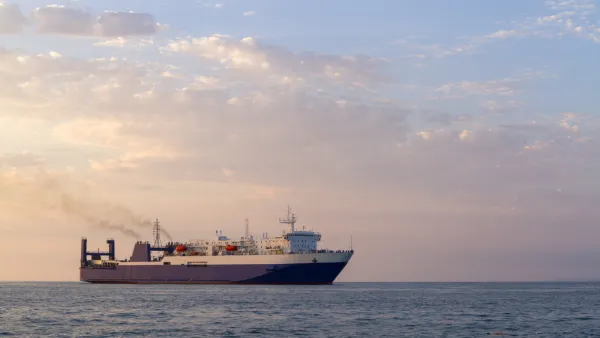Thanks to a Calif. law implemented in 2008 requiring ocean-going ships to switch from high-sulfur bunker fuel to cleaner fuels within 24 miles of the coast, Bay Area air quality significantly improved by reducing deadly particulate emissions.
Ralph Borrmann, public information officer for the Bay Area Air Quality Management District, looks at a new scientific study that shows that cleaner fuels used by ocean-going vessels are cleaning the air in the Bay Area. "Effects of Switching to Lower Sulfur Marine Fuel Oil on Air Quality in the San Francisco Bay Area", co-authored by BAAQMD, UC Davis and UC Berkeley, was published in Environmental Science & Technology in August.
Mandated use of low-sulfur maritime fuels results from a 2008 state law requiring ocean-going vessels "to switch to cleaner fuels 24 miles before they enter local waters in order to improve air quality and public health", according to Borrmann.
Matthew Wald of The New York Times wrote on July 25, 2008, that "California ordered the 2,000 big ships calling on its ports every year to switch to low-sulfur fuel whenever they were within 24 miles of the coast, in what state officials said was the world’s strictest emissions standards for marine diesels."
The rule, promulgated by the California Air Resources Board, would require switching to a fuel with 97 percent less sulfur. Sulfur in diesel fuel combines with other pollutants to make tiny particles that are linked to cancer and other illnesses
The rule was contested by the Pacific Merchant Shipping Association (PMSA) and upheld by the the Ninth Circuit Court of Appeals in 2011. However, the PMSA now admit that "compliance was going smoothly despite the higher cost of the new fuel."
Borrmann writes that analysis of air samples containing a trace metal associated with bunker fuels found that PM 2.5 (particulate matter 2.5 microns in diameter or smaller) levels in the Bay Area dropped by 3 percent as a result of the fuel conversion.
Jack Broadbent, executive director of BAAQMD, stated, "It underscores the cumulative improvement in air quality which has resulted from state and local efforts to reduce diesel air pollution from ships, trucks, and rail at our ports."
On Sept. 20, Stephanie M. Lee of the San Francisco Chronicle wrote about the broader effort, including measures to address truck and rail emissions associated with "goods (or freight) movement" in operations at the Port of Oakland, the fourth busiest seaport in the U.S.
Data released this week show that from 2005 to 2012 the port's diesel particulate matter emissions, which are linked to respiratory problems, have tumbled 70 percent, from 261 tons to 77 tons.
She writes that another state law affecting ship emissions requiring "cold-ironing" (using shore-based electricity rather than running on fuel - regardless of sulfur content) when docked.
Under state law, by 2014, half of container ship, passenger ship and refrigerated cargo-ship fleets must use local power while docked. By 2020, 80 percent must do so.
The effect is noticeable, admit even the toughest Port critics. "The trucking fleets have been cleaned up significantly, just to the casual observer," said Beveridge, 61, co-director of the West Oakland Environmental Indicators Project. "And I think we see at this point we're beginning to see fewer ships at the dock blowing out big bouts of black smoke."
On a national level, new EPA regulations took effect in August, 2012, that require that "ships traveling within 200 nautical miles of the non-Arctic U.S. and Canadian coasts use fuels with a sulfur content of 10,000 parts per million or less, falling to a 1,000 ppm sulfur limit by 2015. The rule will also achieve an 80 percent reduction in smog-forming oxides of nitrogen by 2016."
FULL STORY: Bay Area air cleaner due to state's low sulfur fuel law for ships

National Parks Layoffs Will Cause Communities to Lose Billions
Thousands of essential park workers were laid off this week, just before the busy spring break season.

Retro-silient?: America’s First “Eco-burb,” The Woodlands Turns 50
A master-planned community north of Houston offers lessons on green infrastructure and resilient design, but falls short of its founder’s lofty affordability and walkability goals.

Delivering for America Plan Will Downgrade Mail Service in at Least 49.5 Percent of Zip Codes
Republican and Democrat lawmakers criticize the plan for its disproportionate negative impact on rural communities.

Test News Post 1
This is a summary

Test News Headline 46
Test for the image on the front page.

Balancing Bombs and Butterflies: How the National Guard Protects a Rare Species
The National Guard at Fort Indiantown Gap uses GIS technology and land management strategies to balance military training with conservation efforts, ensuring the survival of the rare eastern regal fritillary butterfly.
Urban Design for Planners 1: Software Tools
This six-course series explores essential urban design concepts using open source software and equips planners with the tools they need to participate fully in the urban design process.
Planning for Universal Design
Learn the tools for implementing Universal Design in planning regulations.
EMC Planning Group, Inc.
Planetizen
Planetizen
Mpact (formerly Rail~Volution)
Great Falls Development Authority, Inc.
HUDs Office of Policy Development and Research
NYU Wagner Graduate School of Public Service




























